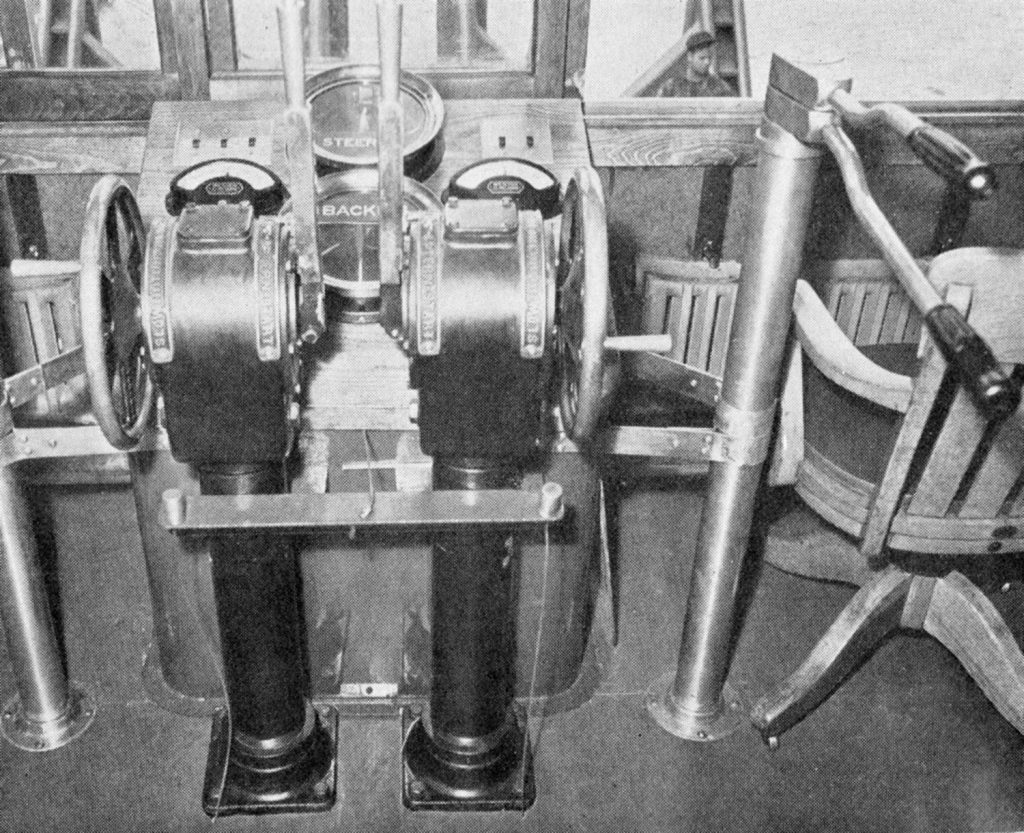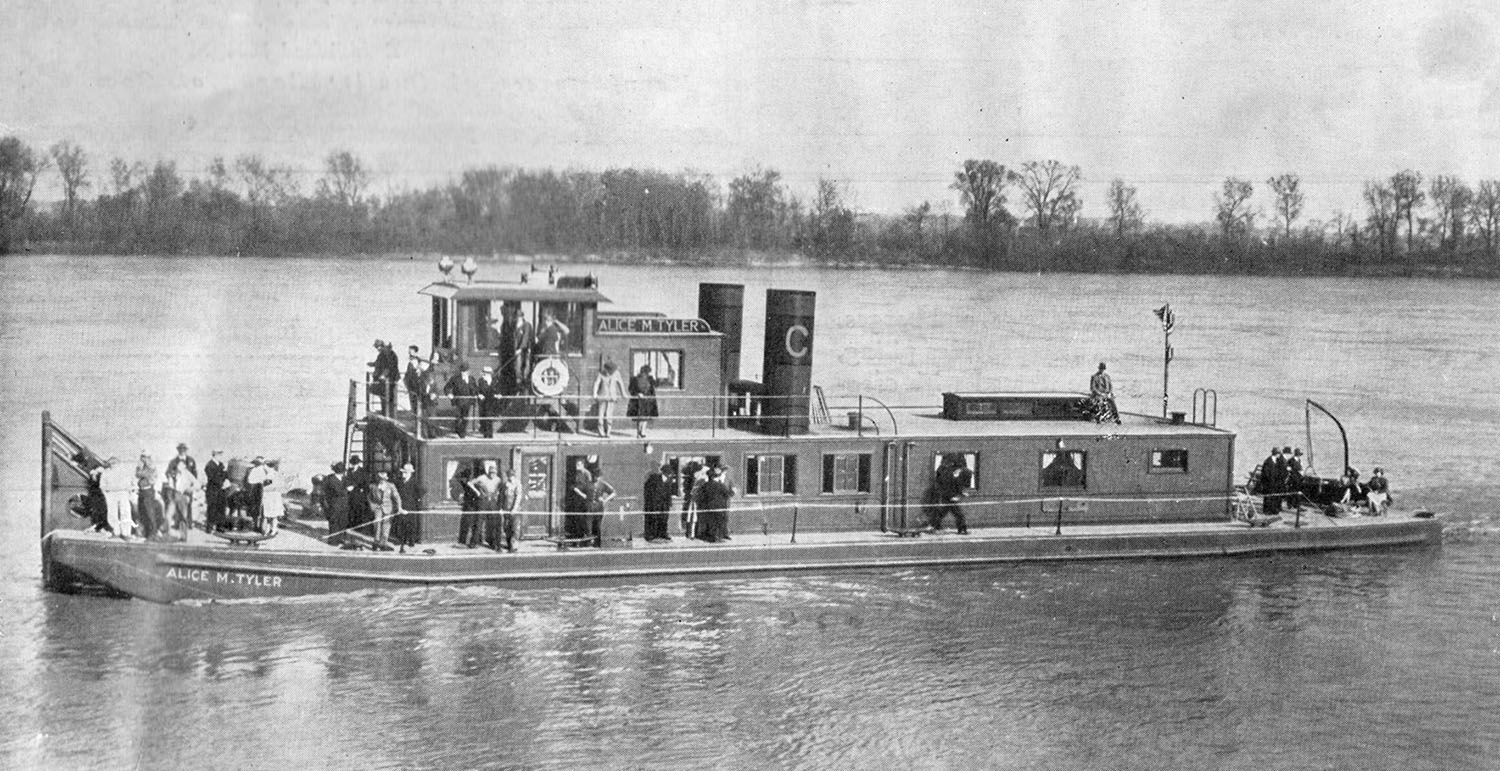After St. Louis Shipbuilding & Steel Company had delivered the streamlined J.H. Duffy (WJ, August 7), one would have thought that subsequent boats turned out by the yard would be of a similar modernized design. However, the next significant boat built by St. Louis in 1938 was the St. Louis Socony, a 130 by 25-foot, 1,200 hp. vessel for the Socony Vacuum Oil Company. While it was constructed entirely of steel, the design was decidedly boxy and square, a far cry from the aerodynamic J.H. Duffy. The next towboat turned out by St. Louis would take an even harder turn to the past.
The Alice M. Tyler was launched at the ways of St. Louis Shipbuilding on April 20, 1939. The launch was mentioned in the April 22, 1939, issue of The Waterways Journal. The following week, the April 29 issue had a photo of the launching in a front-cover ad for Fairbanks-Morse diesels, and within the issue was a photo of the boat afloat just after the launch. The boat had a steel hull measuring 110 by 30 feet and was powered by a pair of Fairbanks-Morse five-cylinder, 14 by 17 Model 35 marine diesels rated at 375 hp. each for a total of 750 hp. The cast-steel propellers were 6 feet in diameter, and the rudder setup was described as three steering aft of the wheels, with four flanking rudders forward. There were generators that were driven from the main engine flywheels, and when the boat was stationary a two-cylinder F-M model 36 diesel was provided for auxiliary power. The owner was George N. Childs of Mapleton, Ill.
The article in the April 29 WJ says that Childs hosted a luncheon for a group of 60 “prominent persons” at the Mark Twain Hotel in St. Louis on April 27. Among those present were representatives of the Dewey Portland Cement Company, which the boat would be working for, several from Fairbanks-Morse and the Neare, Gibbs & Company, insurers. Also among the guests were Mr. & Mrs. James E. Howard of the Howard Ship Yard & Dock Company, Jeffersonville, Ind. The luncheon was “followed by a ride on his new all-steel diesel towboat Alice M. Tyler.” Since the boat had been launched only one week prior, it must have hit the water nearly complete and ready to work.
Despite the article stating that the boat was “all-steel” as most boats were being built at that time, the cabin structure of the Tyler was crafted completely of wood, except for the areas around the engineroom. As with the Socony boat built just prior to the Tyler, the style was quite box-like. The pilothouse was situated pool-style, forward of a small cabin on the second deck. There were twin smokestacks aft of this cabin. Accommodations for 12 crew were provided, in addition to cabins for the captain and pilot and a guest room.
The May 6, 1939, issue of the WJ had a photo of the Alice M. Tyler on the front cover in a full-page ad for St. Louis Ship, and interior photos with detailed descriptions of the new craft on pages 9 and 10. The interior of the pilothouse was shown, with a close-up shot of the massive mechanical engine controls. (These huge controls would be in use throughout the life of the boat). An engineroom telegraph or indicator was also rigged in case it became necessary to operate the direct-reversing engines from the engineroom.

The boat was to depart on its first trip on April 29, and it would be towing coal from Alton, Ill., to the Dewey Portland Cement Company facility at Davenport, Iowa (the same trade that the Str. Transporter had tried briefly in 1937—WJ July 17). The boat was named for Mrs. Alice M. Tyler, wife of Frank E. Tyler of Kansas City, president of the Dewey Cement Company.
In 1943, the Tyler was sold to the Marquette Cement Mfg. Company and renamed Richard Moyle. Mr. Moyle had been a founder of the Marquette firm and was a long-time general superintendent of the operations. It would remain in the Marquette fleet for the next 19 years, operating on the Upper Mississippi and most likely painted a light blue color. (If anyone knows for sure, please let me know.) In 1962, it was sold to Ohio Valley Towing Company, Pittsburgh, and it would spend the rest of its existence on the upper Ohio River. It was sold in 1967 to Elmer P. Grimm and again sold in 1969 to Eugene Bartley, both of the Pittsburgh area. In 1970 it was sold for a final time to G&C Towing, Point Pleasant, W.Va.
At some point in the Upper Ohio ownerships, the starboard main engine of the boat suffered a catastrophic failure. A Waukesha diesel engine was installed in place of the big Fairbanks. Though of similar horsepower, the Waukesha was tiny in comparison, and the block and other parts of the massive Fairbanks engine were placed against the outside bulkhead as a counterbalance to keep the boat level. The only time this writer was ever aboard the boat was after G&C had acquired it, and this engine arrangement was in evidence. After dismantling the sternwheel Harry Z, which had also been acquired by G&C in 1970, the Fairbanks engine from that boat was placed aboard the Richard Moyle in place of the Waukesha.
In 1972 the Moyle was renamed Lute. It was often utilized by G&C in the Kanawha River and to make local deliveries around the Point Pleasant area. Photos taken by marine broker Marion Webb in July 1973, and now in the possession of Capt. C.R. Neale, show the boat looking worn and tired. About 1974, the Lute burned at Point Pleasant and was a total loss. It had remained virtually unchanged over the years, except for a type of siding that had been placed on the pilothouse and upper cabin.
Caption for top photo: The Alice M. Tyler new at St. Louis as pictured in the May 6, 1939, WJ.
Capt. David Smith can be contacted at davidsmith1955obc@gmail.com.




